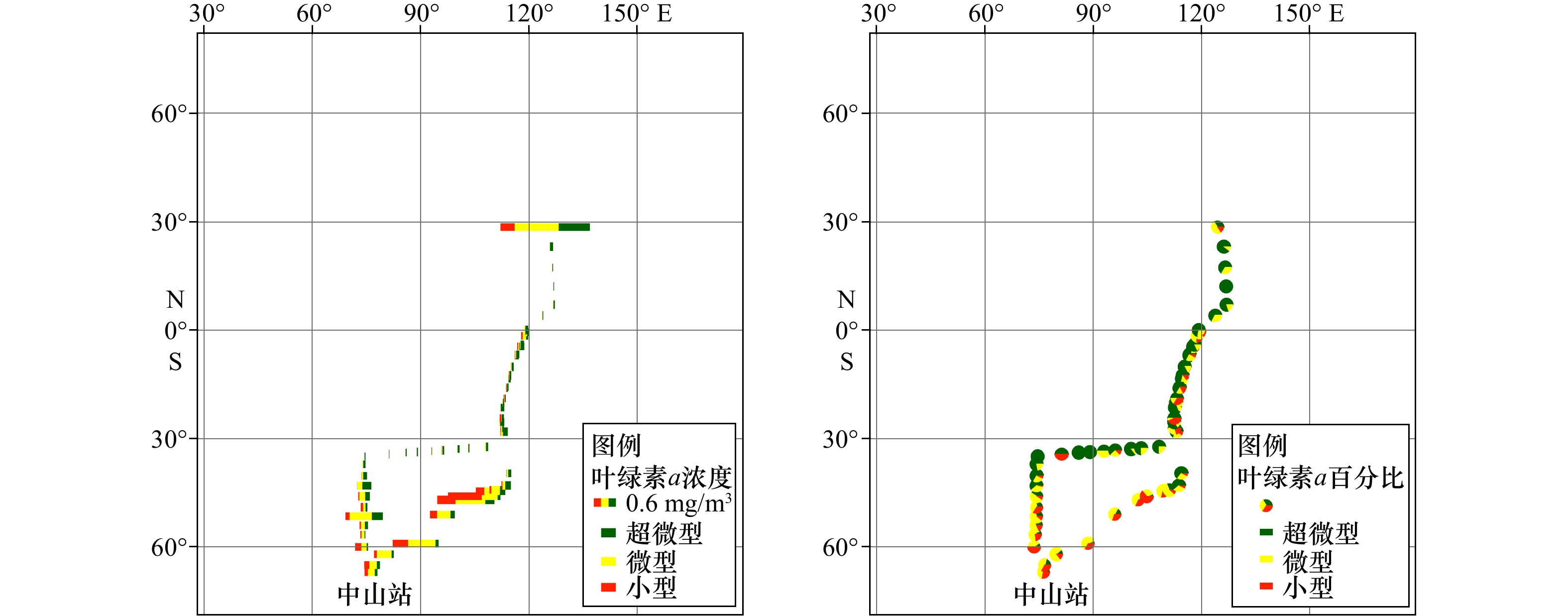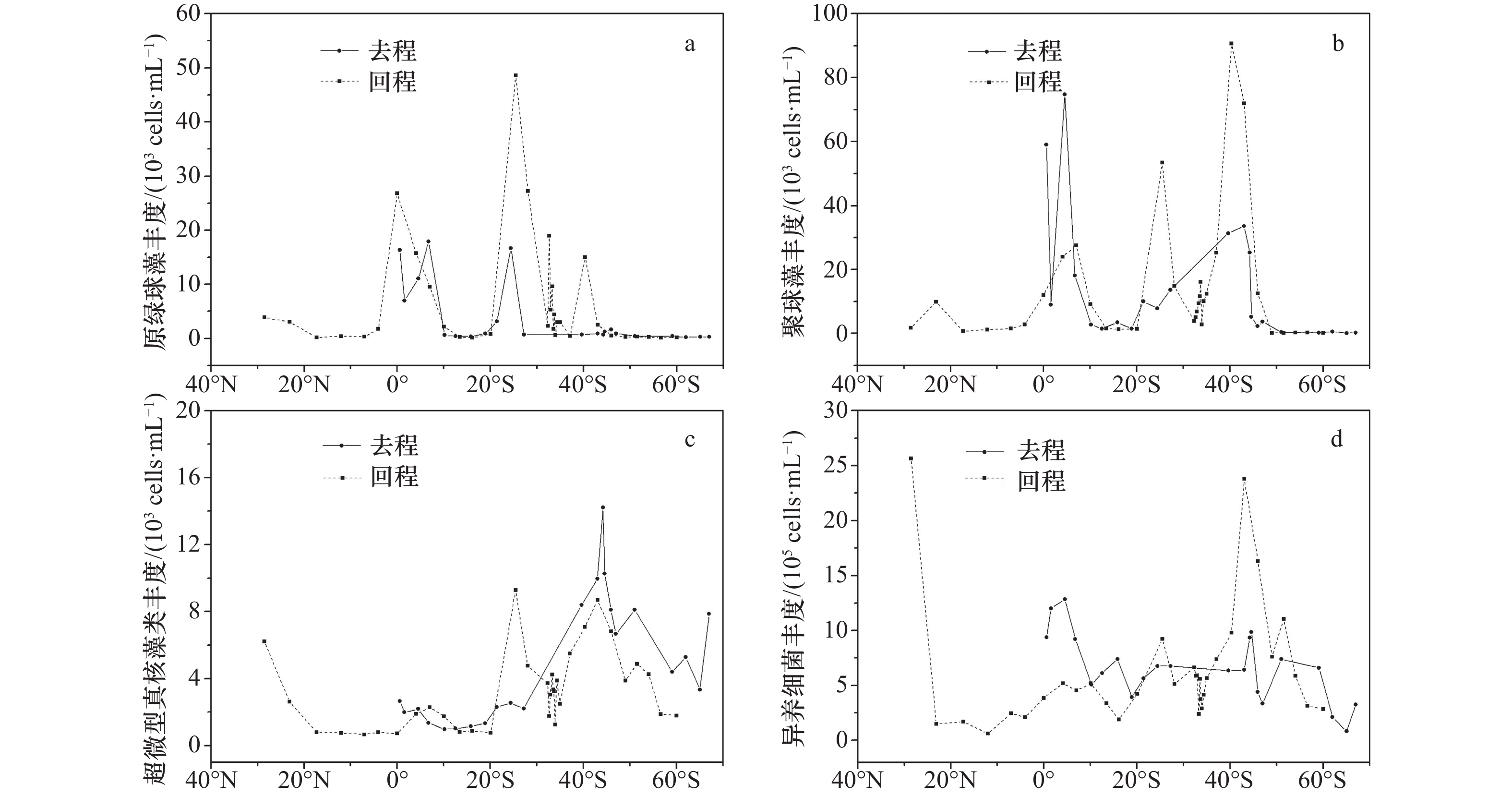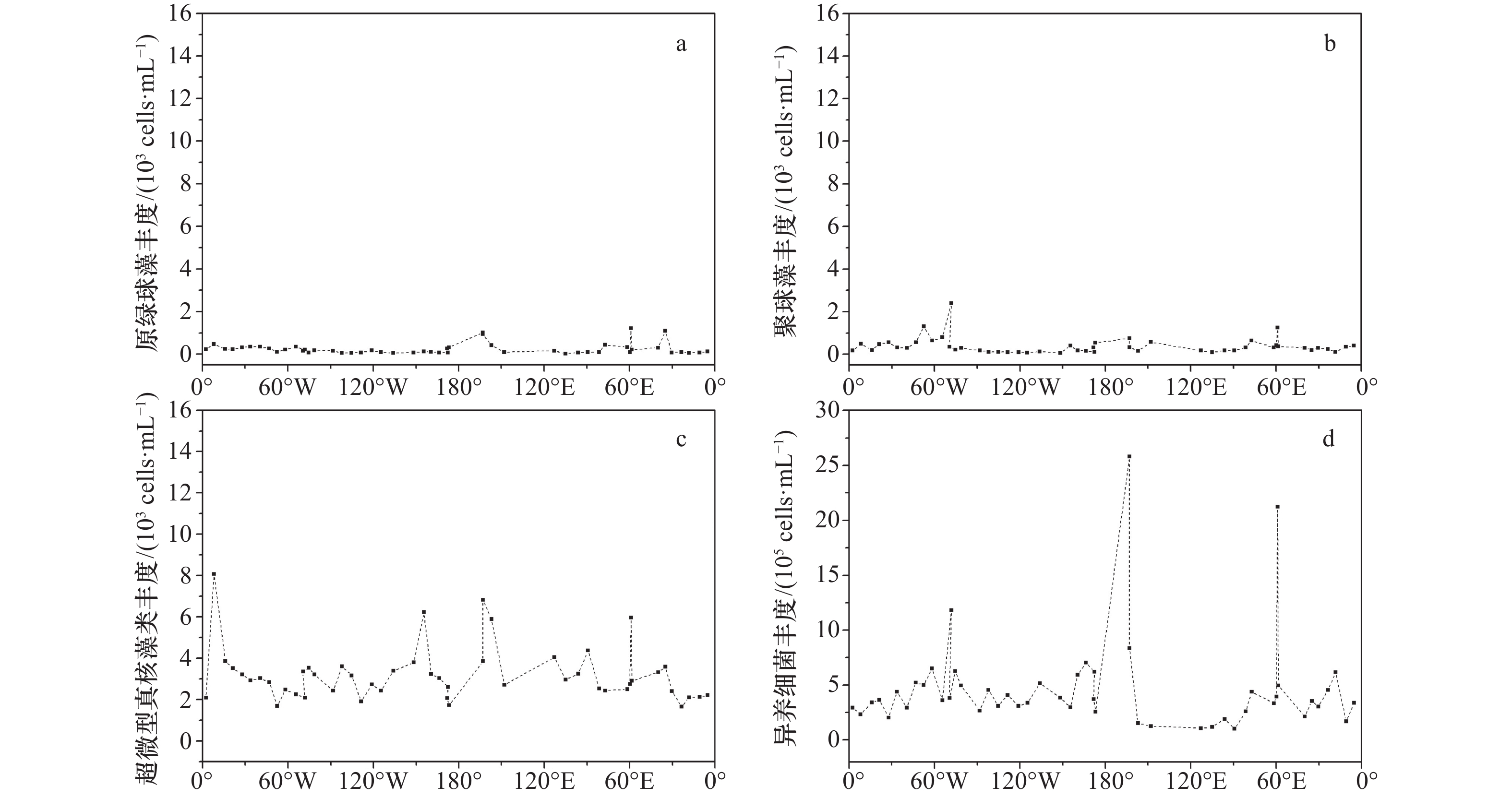Distribution and environmental impact factors of ultraplankton abundance in the surface water of the Southern Ocean and Antarctic cruise routes
-
摘要: 南极考察航线跨越全球多个大洋,对认识超微型浮游生物在全球尺度分布及变化具有重要意义。依托中国第33次南极考察,利用流式细胞仪对航线海表水样中的超微型浮游生物进行了现场测定。结果表明,在热带与温带海域,超微型浮游生物量可占总叶绿素a浓度的60%以上,在南大洋则集中在15%~40%;原绿球藻主要分布在40°S以北海域,聚球藻主要分布在50°S以北海域,而超微型真核藻类和异养细菌则在沿线各海域均有明显分布。在纬向上,原绿球藻、聚球藻、超微型真核藻类和异养细菌的平均丰度分别为(5.50±9.09)×103 cells/mL、(13.56±20.33)×103 cells/mL、(3.87±3.08)×103 cells/mL和(6.39±4.78)×105 cells/mL;南大洋海域,超微型真核藻类和异养细菌的平均丰度分别为(3.31±1.46)×103 cells/mL和(4.68±4.39)×105 cells/mL,在少数站位检测到较低丰度的聚球藻,平均值为(0.38±0.39)×103 cells/mL。纬向上,超微型真核藻类与温度呈显著负相关,原绿球藻与温度呈正相关,盐度与营养盐对其影响较弱;南大洋海域,超微型浮游生物与营养盐显著相关,在南极半岛海域大量消耗硝酸盐、磷酸盐和硅酸盐,而在罗斯海则主要利用硝酸盐与磷酸盐。Abstract: The Antarctic cruise routes across different regions of the global oceans, it is of great significance to understand the global distribution of ultraplankton. During 33rd Chinese Antarctic Expedition, we used flow cytometry to investigate large-scale latitudinal distribution of ultraplankton abundance and its effect factors in the surface water along the cruise routes. The results showed that picoplankton accounted for 60% of total chlorophyll a (Chl a) concentration in the tropic and temperate zones and the contribution of picoplankton to total Chl a concentration varied from 15% to 40% in the Southern Ocean. Prochlorococcus (Pro) were mainly distributed in the north of 40°S, Synechococcus (Syn) were distributed in the north of 50°S, while pico-eukaryotes (PEuk) and heterotrophic bacteria (HBac) were detected and distributed in the Southern Ocean and along the cruise routes. The average abundance of Pro, Syn, PEuk and HBac were (5.50±9.09)×103 cells/mL, (13.56±20.33)×103 cells/mL, (3.87± 3.08)×103
cells/mL and (6.39±4.78)×105 cells/mL respectively on the latitudinal routes. The average abundance of PEuk and HBac were (3.31±1.46)×103 cells/mL and (4.68±4.39)×105 cells/mL in the Southern Ocean. Syn cells were detected in a few stations of the Antarctic waters, the average abundance was (0.38±0.39)×103 cells/mL. The results of environmental factor correlation analysis showed that there was a distinct negative correlation between PEuk abundance and temperature, and a distinct positive correlation between Pro abundance and temperature. Salinity and nutrients did not have obvious influence on the distribution of ultraplankton along the latitudinal. There was a close negative correlation between ultraplankton abundance and nutrients in the Southern Ocean. Nitrate, phosphate and silicate were important factors in the Antarctic Peninsula. Nitrate and phosphate were main environmental factors in the Ross Sea. -
Key words:
- ultraplankton /
- Prochlorococcus /
- Synechococcus /
- pico-eukaryotes /
- Antarctic /
- Southern Ocean
-
表 1 超微型浮游生物丰度与相关环境因子的Pearson相关性分析
Tab. 1 Pearson correlation analysis between ultraplankton abundance and related environmental parameters
航段 参数 温度 盐度 硝酸盐和亚
硝酸盐浓度磷酸盐
浓度硅酸盐
浓度总叶绿素a
浓度Syn
丰度Pro
丰度PEuk
丰度纬向(n=55) Syn丰度 0.165 −0.102 −0.239 −0.155 −0.221 −0.152 − − − Pro丰度 0.320* −0.01 −0.261 −0.203 −0.179 −0.152 0.446** − − PEuk丰度 −0.560** 0.130 −0.058 0.003 0.077 0.437** 0.326** 0.041 − HBac丰度 −0.039 −0.177 0.069 0.103 −0.247 0.442* 0.447** 0.116 0.408** 总叶绿素a浓度 −0.597** −0.058 0.284 0.263 0.235 − − − − 0°~120°E(n=20) Syn丰度 −0.407 0.050 −0.232 −0.254 −0.252 0.092 − − − PEuk丰度 −0.125 −0.153 0.201 0.204 0.366 0.479* −0.214 − − HBac丰度 −0.214 0.164 −0.132 −0.147 −0.297 −0.225 0.764** − −0.307 总叶绿素a浓度 −0.489* −0.280 −0.253 −0.281 −0.073 − − − − 120°E~120°W(n=13) Syn丰度 −0.242 0.264 −0.644* −0.446 0.448 0.450 − − − PEuk丰度 0.058 −0.652* −0.339 −0.586* −0.167 −0.041 0.012 − − HBac丰度 −0.118 0.149 −0.601* −0.356 0.458 0.614* 0.500 − 0.084 总叶绿素a浓度 −0.405 0.457 −0.588* −0.398 0.653* − − − − 120°W~0°(n=17) Syn丰度 0.257 0.525* −0.528* −0.622** −0.048 0.874** − − − PEuk丰度 0.084 0.301 −0.483* −0.407 0.092 0.735** 0.510* − − HBac丰度 0.056 0.430 −0.434 −0.461 0.187 0.951** 0.871** − 0.562* 总叶绿素a浓度 0.028 0.389 −0.438 −0.448 0.219 − − − − 注:**代表相关性极显著(p<0.01);*代表相关性显著(p<0.05);−代表数据已出现1次,不再重复显示。 表 2 南大洋和北冰洋中超微型浮游生物丰度
Tab. 2 Abundance of ultraplankton in the Southern Ocean and the Arctic Ocean
具体区域 经纬度 Pro丰度/
(103 cells·mL−1)Syn丰度/
(103 cells·mL−1)PEuk丰度/
(103 cells·mL−1)HBac丰度/
(105 cells·mL−1)采样年月 参考文献 南极海域/
南大洋环南极表层 60°~70°S − 0.06~2.40
(0.38±0.39)1.66~8.07
(3.31±1.46)1.01~25.82
(4.68±4.39)2016年12月至2017年2月 本研究 环南极表层 60°~70°S − − 0.76~10.35
(3.62±1.82)0.84~13.2
(3.10±0.28)2009年10−11月 文献[5] 德雷克海峡 55.5°~62°S − (0.61±0.50) (0.37±0.22) − 1989年12月 文献[8] 南大西洋 62°~64°S − (0.10±0.11) (1.01±0.81) − 1989年12月至1990年1月 文献[8] 南印度洋 62°~64°S − (0.06±0.06) (0.81±0.84) − 1989年12月至1990年1月 文献[8] 南极锋区 46°S, 62°49′E − 2~4 最大12 2~5 1999年1月 文献[37] 南极锋区 44°S, 64°10′E − 最大24 最大7~8 最大9 1999年2月 文献[37] 北极海域/
北冰洋白令海海盆区 55°~65°N, 162°E~157°W − 0.01~41.27
(4.20)0.11~30.70
(7.18)0.99~17.02
(4.80)2008年6−9月 文献[35] 楚科奇海 68°~75°N, 170°~155°W − 1.50~32.16 0.03~12.03
(2.56)0.41~13.88
(5.46)2008年6−9月 文献[35] 巴伦支海 70°~79°N, 3°~23°E − 3~40 − − 2002年8−9月 文献[34] 北大西洋 50°~61°N (6.80±12.80) (21.50±17.90) (0.90±3.50) (10.68±5.53) 1993年7−8月 文献[27] 注:括号内为平均值±标准偏差或平均值;−代表无数据。 -
[1] 焦念志. 海洋微型生物生态学[M]. 北京: 科学出版社, 2006.Jiao Nianzhi. Marine Microbial Ecology[M]. Beijing: Science Press, 2006. [2] Azam F, Malfatti F. Microbial structuring of marine ecosystems[J]. Nature Reviews Microbiology, 2007, 5(10): 782−791. doi: 10.1038/nrmicro1747 [3] Jiao Nianzhi, Luo Tingwei, Zhang Rui, et al. Presence of Prochlorococcus in the aphotic waters of the western Pacific Ocean[J]. Biogeosciences, 2014, 11(8): 2391−2400. doi: 10.5194/bg-11-2391-2014 [4] 焦念志, 杨燕辉. 中国海原绿球藻研究[J]. 科学通报, 2002, 47(7): 485−491. doi: 10.3321/j.issn:0023-074X.2002.07.002Jiao Nianzhi, Yang Yanhui. Study on Prochlorococcus in China seas[J]. Chinese Science Bulletin, 2002, 47(7): 485−491. doi: 10.3321/j.issn:0023-074X.2002.07.002 [5] 白晓歌. 泛三大洋微微型浮游生物的分布及其与环境因子的相关性[D]. 青岛: 中国海洋大学, 2010.Bai Xiaoge. Distribution and structure of picoplankton and their relationships with environmental parameters in the western Pacific, Indian Ocean, the encircling Southern Ocean and Antarctic waters[D]. Qingdao: Ocean University of China, 2010. [6] 梁彦韬. 海洋上层和深层超微型浮游生物丰度的大尺度分布[D]. 厦门: 厦门大学, 2014.Liang Yantao. Large-scale distributions of the abundances of picoplankton in the ocean surface and deep waters[D]. Xiamen: Xiamen University, 2014. [7] 张武昌, 陈雪, 李海波, 等. 海洋浮游微食物网对氮、磷营养盐的再生研究综述[J]. 海洋通报, 2016, 35(3): 241−251. doi: 10.11840/j.issn.1001-6392.2016.03.001Zhang Wuchang, Chen Xue, Li Haibo, et al. Review of nutrient (nitrogen and phosphorus) regeneration in the marine pelagic microbial food web[J]. Marine Science Bulletin, 2016, 35(3): 241−251. doi: 10.11840/j.issn.1001-6392.2016.03.001 [8] 宁修仁, 史君贤, 刘子琳, 等. 南大洋蓝细菌和微微型光合真核生物的丰度与分布[J]. 中国科学(C辑), 1996,26(2): 164−171.Ning Xiuren, Shi Junxian, Liu Zilin, et al. Abundance and distribution of cyanibacteria and picoeukaryotes in the Southern Ocean[J]. Science in China (Series C), 1996,26(2): 164−171. [9] Wright S W, Ishikawa A, Marchant H J, et al. Composition and significance of picophytoplankton in Antarctic waters[J]. Polar Biology, 2009, 32(5): 797−808. doi: 10.1007/s00300-009-0582-9 [10] Andrade L, Gonzalez A M, Araujo F V, et al. Flow cytometry assessment of bacterioplankton in tropical marine environments[J]. Journal of Microbiological Methods, 2003, 55(3): 841−850. doi: 10.1016/j.mimet.2003.08.002 [11] 焦念志, 杨燕辉. 四类海洋超微型浮游生物的同步监测[J]. 海洋与湖沼, 1999, 30(5): 506−511. doi: 10.3321/j.issn:0029-814X.1999.05.007Jiao Nianzhi, Yang Yanhui. Simultaneous monitoring of autotrophic picoplankton and heterotrophic bacteria[J]. Oceanologia et Limnologia Sinica, 1999, 30(5): 506−511. doi: 10.3321/j.issn:0029-814X.1999.05.007 [12] Li W K W, Dickie P M. Monitoring phytoplankton, bacterioplankton, and virioplankton in a coastal inlet (Bedford Basin) by flow cytometry[J]. Cytometry, 2001, 44(3): 236−246. doi: 10.1002/1097-0320(20010701)44:3<236::AID-CYTO1116>3.0.CO;2-5 [13] 何剑锋, 崔世开, 张芳, 等. 北冰洋海域微食物环研究进展[J]. 生态学报, 2011, 31(23): 7279−7286.He Jianfeng, Cui Shikai, Zhang Fang, et al. Progress in research on the marine microbial loop in the Arctic Ocean[J]. Acta Ecologica Sinica, 2011, 31(23): 7279−7286. [14] 赵苑. 黄海和东海微微型浮游生物分布研究[D]. 青岛: 中国海洋大学, 2010.Zhao Yuan. Spatial and temporal distribution of picoplankton in Yellow Sea and East China Sea[D]. Qingdao: Ocean University of China, 2010. [15] 季倩. 长江口邻近海域水体及底栖微微型浮游生物研究[D]. 上海: 华东师范大学, 2008.Ji Qian. Study of the microbial community structure in the seawater and benthic environment adjacent to the Changjiang Estuary[D]. Shanghai: East China Normal University, 2008. [16] Jiao Nianzhi, Yang Yanhui. Ecological studies on Prochlorococcus in China seas[J]. Chinese Science Bulletin, 2002, 47(15): 1243−1250. [17] Chen Bingzhang, Wang Lei, Song Shuqun, et al. Comparisons of picophytoplankton abundance, size, and fluorescence between summer and winter in northern South China Sea[J]. Continental Shelf Research, 2011, 31(14): 1527−1540. doi: 10.1016/j.csr.2011.06.018 [18] Lin Ling, He Jianfeng, Zhao Yunlong, et al. Flow cytometry investigation of picoplankton across latitudes and along the circum Antarctic Ocean[J]. Acta Oceanologica Sinica, 2012, 31(1): 134−142. doi: 10.1007/s13131-012-0185-0 [19] Flombaum P, Gallegos J L, Gordillo R A, et al. Present and future global distributions of the marine Cyanobacteria Prochlorococcus and Synechococcus[J]. Proceedings of the National Academy of Sciences of the United States of America, 2013, 110(24): 9824−9829. doi: 10.1073/pnas.1307701110 [20] Flombaum P, Wang W L, Primeau F W, et al. Global picophytoplankton niche partitioning predicts overall positive response to ocean warming[J]. Nature Geoscience, 2020, 13(2): 116−120. doi: 10.1038/s41561-019-0524-2 [21] 中华人民共和国国家质量监督检验检疫总局, 中国国家标准化管理委员会. GB/T 30737−2014, 海洋微微型光合浮游生物的测定 流式细胞测定法[S]. 北京: 中国标准出版社, 2014.General Administration of Quality Supervision, Inspection and Quarantine of the People’s Republic of China, Standardization Administration. GB/T 30737−2014, Determination of marine photosynthetic picoplankton-flow cytometry[S]. Beijing: China Standard Press, 2014. [22] 潘洛安, 张利华, 张经. 应用流式细胞术测定水体异养细菌[J]. 海洋环境科学, 2005, 24(1): 54−58. doi: 10.3969/j.issn.1007-6336.2005.01.016Pan Luo’an, Zhang Lihua, Zhang Jing. Determination of heterotrophic bacteria in aquatic environments by flow cytometry[J]. Marine Environmental Science, 2005, 24(1): 54−58. doi: 10.3969/j.issn.1007-6336.2005.01.016 [23] 中华人民共和国国家质量监督检验检疫总局, 中国国家标准化管理委员会. GB/T 12763.6−2007, 海洋调查规范 第6部分: 海洋生物调查[S]. 北京: 中国标准出版社, 2008.General Administration of Quality Supervision, Inspection and Quarantine of the People’s Republic of China, Standardization Administration. GB/T 12763.6−2007, Specifications for oceanographic survey. Part 6: Marine biological survey[S]. Beijing: China Standard Press, 2008. [24] Holm-Hansen O, Lorenzen C J, Homes R W, et al. Fluorometric determination of chlorophyll[J]. ICES Journal of Marine Science, 1965, 30(1): 3−15. doi: 10.1093/icesjms/30.1.3 [25] 乐凤凤, 郝锵, 金海燕, 等. 2012年楚科奇海及其邻近海域浮游植物现存量和初级生产力粒级结构研究[J]. 海洋学报, 2014, 36(10): 103−115.Le Fengfeng, Hao Qiang, Jin Haiyan, et al. Size structure of standing stock and primary production of phytoplankton in the Chukchi Sea and adiacent sea area during the summer of 2012[J]. Haiyang Xuebao, 2014, 36(10): 103−115. [26] Johnson Z, Zinser E, Coe A, et al. Niche partitioning among Prochlorococcus ecotypes along ocean-scale environmental gradients[J]. Science, 2006, 311(5768): 1737−1740. doi: 10.1126/science.1118052 [27] Buck K R, Chavezt F P, Campbell L. Basin-wide distributions of living carbon components and the inverted trophic pyramid of the central gyre of the North Atlantic Ocean, summer 1993[J]. Aquatic Microbial Ecology, 1996, 10(3): 283−298. [28] Doolittle D F, Li W K W, Wood A M. Wintertime abundance of picoplankton in the Atlantic sector of the Southern Ocean[J]. Nova Hedwigia, 2008, 133(1): 147−160. [29] Xia Xiaomin, Cheung S, Endo H, et al. Latitudinal and vertical variation of Synechococcus assemblage composition along 170°W transect from the South Pacific to the Arctic Ocean[J]. Microbial Ecology, 2019, 77(2): 333−342. doi: 10.1007/s00248-018-1308-8 [30] Cottrell M T, Kirchman D L. Photoheterotrophic microbes in the Arctic Ocean in summer and winter[J]. Applied and Environmental Microbiology, 2009, 75(15): 4958−4966. doi: 10.1128/AEM.00117-09 [31] Huang Sijun, Wilhelm S W, Harvey H R, et al. Novel lineages of Prochlorococcus and Synechococcus in the global oceans[J]. The ISME Journal, 2012, 6(2): 285−297. doi: 10.1038/ismej.2011.106 [32] Powell L M, Bowman J P, Skerratt J H, et al. Ecology of a novel Synechococcus clade occurring in dense populations in saline Antarctic lakes[J]. Marine Ecology Progress, 2005, 291: 65−80. doi: 10.3354/meps291065 [33] Walker T D, Marchant H J. Seasonal occurrence of chroococcoid cyanobacteria at an Antarctic coastal site[J]. Polar Biology, 1989, 9(3): 193−196. doi: 10.1007/BF00297175 [34] Zwirglmaier K, Jardillier L, Ostrowski M, et al. Global phylogeography of marine Synechococcus and Prochlorococcus reveals a distinct partitioning of lineages among oceanic biomes[J]. Environmental Microbiology, 2008, 10(1): 147−161. [35] 林凌. 夏季北极太平洋扇区微微型海洋浮游生物空间分布及环境相关性研究[D]. 上海: 华东师范大学, 2015.Lin Ling. Research on marine picoplankton spatial distribution and environmental effection at Pacific section of Arctic during summer[D]. Shanghai: East China Normal University, 2015. [36] 张武昌, 赵苑, 董逸, 等. 印度洋浮游生态系统的特点及其对全球变暖的响应[J]. 海洋与湖沼, 2022, 53(2): 247−260. doi: 10.11693/hyhz20210900201Zhang Wuchang, Zhao Yuan, Dong Yi, et al. Review on planktonic ecosystem of Indian Ocean and its response to global warming[J]. Oceanologia et Limnologia Sinica, 2022, 53(2): 247−260. doi: 10.11693/hyhz20210900201 [37] Dubreuil C, Denis M, Conan P, et al. Spatial-temporal variability of ultraplankton vertical distribution in the Antarctic frontal zones within 60°–66°E, 43°–46°S[J]. Polar Biology, 2003, 26(11): 734−745. doi: 10.1007/s00300-003-0545-5 [38] 沈国英, 黄凌风, 郭丰, 等. 海洋生态学[M]. 3版. 北京: 科学出版社, 2010.Shen Guoying, Huang Lingfeng, Guo Feng, et al. Marine Ecology [M]. 3rd ed. Beijing: Science Press, 2010. [39] Agawin N S R, Duarte C M, Agustí S. Nutrient and temperature control of the contribution of picoplankton to phytoplankton biomass and production[J]. Limnology and Oceanography, 2000, 45(3): 591−600. doi: 10.4319/lo.2000.45.3.0591 [40] Worden A Z. Picoeukaryote diversity in coastal waters of the Pacific Ocean[J]. Aquatic Microbial Ecology, 2006, 43(2): 165−175. [41] Lovejoy C, Massana R, Pedrós-Alió C. Diversity and distribution of marine microbial eukaryotes in the Arctic Ocean and adjacent seas[J]. Applied and Environmental Microbiology, 2006, 72(5): 3085−3095. [42] Martin J H, Gordon R M, Fitzwater S E. Iron in Antarctic waters[J]. Nature, 1990, 345(6271): 156−158. doi: 10.1038/345156a0 [43] Boyd P W, Watson A J, Law C S, et al. A mesoscale phytoplankton bloom in the polar Southern Ocean stimulated by iron fertilization[J]. Nature, 2000, 407(6805): 695−702. doi: 10.1038/35037500 [44] de Baar H J W, de Jong J T M, Bakker D C E, et al. Importance of iron for plankton blooms and carbon dioxide drawdown in the Southern Ocean[J]. Nature, 1995, 373(6513): 412−415. doi: 10.1038/373412a0 [45] 周亚东, 王春生, 王小谷, 等. 印度洋南赤道流区水体叶绿素a的分布及粒级结构[J]. 生态学报, 2011, 31(16): 4586−4598.Zhou Yadong, Wang Chunsheng, Wang Xiaogu, et al. The distribution of size-fractionated chlorophyll a in the Indian Ocean South Equatorial Current[J]. Acta Ecologica Sinica, 2011, 31(16): 4586−4598. [46] 陈兴群, 张明, 陈其焕. 热带太平洋西部及赤道暖水区的初级生产力[J]. 海洋学报, 2002, 24(1): 86−95.Chen Xingqun, Zhang Ming, Chen Qihuan. Primary production in the western tropical Pacific and equatorial warm waters[J]. Haiyang Xuebao, 2002, 24(1): 86−95. [47] Hayward T L. The nutrient distribution and primary production in the central North Pacific[J]. Deep-Sea Research Part A. Oceanographic Research Papers, 1987, 34(9): 1593−1627. doi: 10.1016/0198-0149(87)90111-7 [48] 倪晓波, 黄大吉. 海洋次表层叶绿素最大值的分布和形成机制研究[J]. 海洋科学, 2006, 30(5): 58−70. doi: 10.3969/j.issn.1000-3096.2006.05.012Ni Xiaobo, Huang Daji. Subsurface chlorophyll maximum: its temporal-spatial distribution and formation mechanism in the ocean[J]. Marine Sciences, 2006, 30(5): 58−70. doi: 10.3969/j.issn.1000-3096.2006.05.012 [49] 马英, 焦念志. 聚球藻(Synechococcus)分子生态学研究进展[J]. 自然科学进展, 2004, 14(9): 967−972. doi: 10.3321/j.issn:1002-008X.2004.09.002Ma Ying, Jiao Nianzhi. Research progress on molecular ecology of Synechococcus[J]. Progress in Natural Science, 2004, 14(9): 967−972. doi: 10.3321/j.issn:1002-008X.2004.09.002 -





 下载:
下载:





